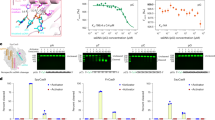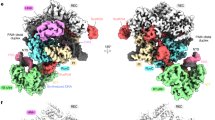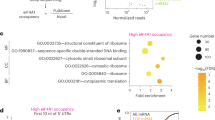Abstract
The presence of a hydroxyl group at the 2′-position in its ribose makes RNA susceptible to hydrolysis. Stabilization of RNAs for storage, transport and biological application thus remains a serious challenge, particularly for larger RNAs that are not accessible by chemical synthesis. Here we present reversible 2′-OH acylation as a general strategy to preserve RNA of any length or origin. High-yield polyacylation of 2′-hydroxyls (‘cloaking’) by readily accessible acylimidazole reagents effectively shields RNAs from both thermal and enzymatic degradation. Subsequent treatment with water-soluble nucleophilic reagents removes acylation adducts quantitatively (‘uncloaking’) and recovers a remarkably broad range of RNA functions, including reverse transcription, translation and gene editing. Furthermore, we show that certain α-dimethylamino- and α-alkoxy- acyl adducts are spontaneously removed in human cells, restoring messenger RNA translation with extended functional half-lives. These findings support the potential of reversible 2′-acylation as a simple and general molecular solution for enhancing RNA stability and provide mechanistic insights for stabilizing RNA regardless of length or origin.

This is a preview of subscription content, access via your institution
Access options
Access Nature and 54 other Nature Portfolio journals
Get Nature+, our best-value online-access subscription
$29.99 / 30 days
cancel any time
Subscribe to this journal
Receive 12 print issues and online access
$259.00 per year
only $21.58 per issue
Buy this article
- Purchase on Springer Link
- Instant access to full article PDF
Prices may be subject to local taxes which are calculated during checkout






Similar content being viewed by others
Data availability
All relevant data supporting the findings of this study are available within the article and supplementary information. The characterization data of all organic compounds are provided within the supplementary information. All reagents generated in this study are available from the corresponding author upon reasonable request. Data used for this paper are also available via figshare at https://figshare.com/articles/dataset/NCHEM-22030547_source_data/19555132. Source data are provided with this paper.
References
Fabre, A. L., Colotte, M., Luis, A., Tuffet, S. & Bonnet, J. An efficient method for long-term room temperature storage of RNA. Eur. J. Hum. Genet. 22, 379–385 (2014).
Wayment-Steele, H. K. et al. Theoretical basis for stabilizing messenger RNA through secondary structure design. Nucleic Acids Res. 49, 10604–10617 (2021).
Kellerman, D. L., York, D. M., Piccirilli, J. A. & Harris, M. E. Altered (transition) states: mechanisms of solution and enzyme catalyzed RNA 2’-O-transphosphorylation. Curr. Opin. Chem. Biol. 21, 96–102 (2014).
Guo, F. et al. Effect of ribose conformation on RNA cleavage via internal transesterification. J. Am. Chem. Soc. 140, 11893–11897 (2018).
Breslow, R. & Chapman, W. H. Jr On the mechanism of action of ribonuclease A: relevance of enzymatic studies with a p-nitrophenylphosphate ester and a thiophosphate ester. Proc. Natl Acad. Sci. USA 93, 10018–10021 (1996).
Lee, J. B., Hong, J., Bonner, D. K., Poon, Z. & Hammond, P. T. Self-assembled RNA interference microsponges for efficient siRNA delivery. Nat. Mater. 11, 316–322 (2012).
Leppek, K. et al. Combinatorial optimization of mRNA structure, stability, and translation for RNA-based therapeutics. Nat. Commun. 13, 1536 (2022).
Hendel, A. et al. Chemically modified guide RNAs enhance CRISPR-Cas genome editing in human primary cells. Nat. Biotechnol. 33, 985–989 (2015).
Miller, P. S. et al. Nonionic nucleic acid analogues. Synthesis and characterization of dideoxyribonucleoside methylphosphonates. Biochemistry 18, 5134–5143 (1979).
Wu, S. Y. et al. 2′-OMe-phosphorodithioate-modified siRNAs show increased loading into the RISC complex and enhanced anti-tumour activity. Nat. Commun. 5, 3459 (2014).
Korobeynikov, V. A., Lyashchenko, A. K., Blanco-Redondo, B., Jafar-Nejad, P. & Shneider, N. A. Antisense oligonucleotide silencing of FUS expression as a therapeutic approach in amyotrophic lateral sclerosis. Nat. Med. 28, 104–116 (2022).
Yin, H. et al. Structure-guided chemical modification of guide RNA enables potent non-viral in vivo genome editing. Nat. Biotechnol. 35, 1179–1187 (2017).
Guinea-Viniegra, J. et al. Targeting miR-21 to treat psoriasis. Sci. Transl. Med. 6, 225re221 (2014).
Wang, S. R. et al. Conditional control of RNA-guided nucleic acid cleavage and gene editing. Nat. Commun. 11, 91 (2020).
Ovodov, S. & Alakhov, Yu,B. mRNA acetylated at 2′-OH-groups of ribose residues is functionally active in the cell-free translation system from wheat embryos. FEBS Lett. 270, 111–114 (1990).
Goldsborough, S. Modified polynucleotides and uses thereof. US patent 2003/0039985 A1 (2003).
Steen, K. A., Siegfried, N. A. & Weeks, K. M. Selective 2’-hydroxyl acylation analyzed by protection from exoribonuclease (RNase-detected SHAPE) for direct analysis of covalent adducts and of nucleotide flexibility in RNA. Nat. Protoc. 6, 1683–1694 (2011).
Fessler, A. B. et al. Water-soluble isatoic anhydrides: a platform for RNA-SHAPE analysis and protein bioconjugation. Bioconjug. Chem. 29, 3196–3202 (2018).
Fessler, A. B., Fowler, A. J. & Ogle, C. A. Directly quantifiable biotinylation using a water-soluble isatoic anhydride platform. Bioconjug. Chem. 32, 904–908 (2021).
Velema, W. A. & Kool, E. T. The chemistry and applications of RNA 2’-OH acylation. Nat. Rev. Chem. 4, 22–37 (2020).
Spitale, R. C. et al. Structural imprints in vivo decode RNA regulatory mechanisms. Nature 519, 486–490 (2015).
Velema, W. A., Kietrys, A. M. & Kool, E. T. RNA control by photoreversible acylation. J. Am. Chem. Soc. 140, 3491–3495 (2018).
Park, H. S., Kietrys, A. M. & Kool, E. T. Simple alkanoyl acylating agents for reversible RNA functionalization and control. Chem. Commun. 55, 5135–5138 (2019).
Kadina, A., Kietrys, A. M. & Kool, E. T. RNA cloaking by reversible acylation. Angew. Chem. Int. Ed. Engl. 57, 3059–3063 (2018).
Habibian, M. et al. Reversible RNA acylation for control of CRISPR-Cas9 gene editing. Chem. Sci. 11, 1011–1016 (2019).
Li, Y. & Breaker, R. R. Kinetics of RNA degradation by specific base catalysis of transesterification involving the 2‘-hydroxyl group. J. Am. Chem. Soc. 121, 5364–5372 (1999).
Soukup, G. A. & Breaker, R. R. Relationship between internucleotide linkage geometry and the stability of RNA. RNA 5, 1308–1325 (1999).
Duffy, K., Arangundy-Franklin, S. & Holliger, P. Modified nucleic acids: replication, evolution, and next-generation therapeutics. BMC Biol. 18, 112 (2020).
Takata, J. et al. Vitamin K prodrugs: 1. Synthesis of amino acid esters of menahydroquinone-4 and enzymatic reconversion to an active form. Pharm. Res. 12, 18–23 (1995).
Johnson, S. L. in Advances in Physical Organic Chemistry Vol. 5 (ed. Gold, V.) 237–330 (Academic Press, 1967).
delCardayre, S. B. & Raines, R. T. Structural determinants of enzymatic processivity. Biochemistry 33, 6031–6037 (1994).
Raines, R. T. Ribonuclease A. Chem. Rev. 98, 1045–1066 (1998).
Garnett, E. R. & Raines, R. T. Emerging biological functions of ribonuclease 1 and angiogenin. Crit. Rev. Biochem. Mol. Biol. 57, 244–260 (2022).
Pace, C. N., Heinemann, U., Hahn, U. & Saenger, W. Ribonuclease T1: structure, function, and stability. Angew. Chem. Int. Ed. Engl. 30, 343–360 (1991).
Tsui, N. B., Ng, E. K. & Lo, Y. M. Stability of endogenous and added RNA in blood specimens, serum, and plasma. Clin. Chem. 48, 1647–1653 (2002).
Daou-Chabo, R. & Condon, C. RNase J1 endonuclease activity as a probe of RNA secondary structure. RNA 15, 1417–1425 (2009).
Wang, Z., Treder, K. & Miller, W. A. Structure of a viral cap-independent translation element that functions via high affinity binding to the eIF4E subunit of eIF4F. J. Biol. Chem. 284, 14189–14202 (2009).
Jencks, W. P. & Carriuolo, J. Reactivity of nucleophilic reagents toward esters. J. Am. Chem. Soc. 82, 1778–1786 (1960).
van der Helm, M. P., Klemm, B. & Eelkema, R. Organocatalysis in aqueous media. Nat. Rev. Chem. 3, 491–508 (2019).
Jarvinen, P., Oivanen, M. & Lonnberg, H. Interconversion and phosphoester hydrolysis of 2′,5′- and 3′,5′-dinucleoside monophosphates: kinetics and mechanisms. J. Org. Chem. 56, 5396–5401 (1991).
Xiao, L., Jun, Y. W. & Kool, E. T. DNA tiling enables precise acylation-based labeling and control of mRNA. Angew. Chem. Int. Ed. Engl. 60, 26798–26805 (2021).
Werber, M. M. & Shalitin, Y. The reaction of tertiary amino alcohols with active esters: I. Acylation and deacylation steps. Bioorg. Chem. 2, 202–220 (1973).
de Jersey, J., Fihelly, A. K. & Zerner, B. On the mechanism of the reaction of tris(hydroxymethyl)aminomethane with activated carbonyl compounds: a model for the serine proteinases. Bioorg. Chem. 9, 153–162 (1980).
Park, H. S., Jash, B., Xiao, L., Jun, Y. W. & Kool, E. T. Control of RNA with quinone methide reversible acylating reagents. Org. Biomol. Chem. 19, 8367–8376 (2021).
Kain, S. R. Green fluorescent protein (GFP): applications in cell-based assays for drug discovery. Drug Discov. Today 4, 304–312 (1999).
Singh, A., Razooky, B. S., Dar, R. D. & Weinberger, L. S. Dynamics of protein noise can distinguish between alternate sources of gene-expression variability. Mol. Syst. Biol. 8, 607 (2012).
Li, X. et al. Generation of destabilized green fluorescent protein as a transcription reporter. J. Biol. Chem. 273, 34970–34975 (1998).
LoPachin, R. M. & Gavin, T. Reactions of electrophiles with nucleophilic thiolate sites: relevance to pathophysiological mechanisms and remediation. Free Radic. Res. 50, 195–205 (2016).
Hou, X., Zaks, T., Langer, R. & Dong, Y. Lipid nanoparticles for mRNA delivery. Nat. Rev. Mater. 6, 1078–1094 (2021).
Raj, A., Peskin, C. S., Tranchina, D., Vargas, D. Y. & Tyagi, S. Stochastic mRNA synthesis in mammalian cells. PLoS Biol. 4, e309 (2006).
Kerpedjiev, P., Hammer, S. & Hofacker, I. L. Forna (force-directed RNA): simple and effective online RNA secondary structure diagrams. Bioinformatics 31, 3377–3379 (2015).
Gu, C. et al. Chemical synthesis of stimuli-responsive guide RNA for conditional control of CRISPR-Cas9 gene editing. Chem. Sci. 12, 9934–9945 (2021).
Warren, L. et al. Highly efficient reprogramming to pluripotency and directed differentiation of human cells with synthetic modified mRNA. Cell Stem Cell 7, 618–630 (2010).
Acknowledgements
This work was supported by a grant from the US National Institutes of Health GM127295 to E.T.K. The funder had no role in study design, data collection and analysis, decision to publish, or preparation of the manuscript. We thank K. Fukui and other staff at the Stanford PAN facility for performing BioAnalyzer QC. We thank Stanford Shared FACS Facility (SSFF) for the flow cytometry analysis. We thank T. McLaughlin in the Vincent Coates Foundation Mass Spectrometry Laboratory, Stanford University Mass Spectrometry (RRID:SCR_017801) for acquiring the HRMS data. We also thank T. Trinh for performing circular dichroism measurements and L. Zheng for the helpful discussion.
Author information
Authors and Affiliations
Contributions
L.F. and E.T.K. conceived the project and designed the experiments. L.F. performed the experiments and data analysis. L.X. performed the Cas9-mediated DNA cleavage assay. Y.W.J. collected and analysed the confocal microscopy data. E.T.K. supervised the work. L.F. and E.T.K. wrote the paper, with input from all authors.
Corresponding author
Ethics declarations
Competing interests
Stanford University has filed a patent application (PCTUS2023/010686) based on the RNA cloaking and uncloaking reagents and methods described in this work, in which L.F. and E.T.K. are named as inventors. The other authors declare no competing interests.
Peer review
Peer review information
Nature Chemistry thanks Ashwani Sharma, Joanna Sztuba-Solinska, Wen Zhang and the other, anonymous, reviewer(s) for their contribution to the peer review of this work.
Additional information
Publisher’s note Springer Nature remains neutral with regard to jurisdictional claims in published maps and institutional affiliations.
Extended data
Extended Data Fig. 1 Reaction conditions of RNA cloaking with acylimidazole reagents.
A heatmap shows reaction conditions for each acylimidazole reagent (1-7) required to introduce the desired level of RNA cloaking using a model 18nt tRF-3005 RNA. The X-axis indicates the number of 2′-acyl adducts per RNA molecule identified by MALDI-TOF. The color intensity of each cell represents the mass intensity of the acyl adduct peak (numbers at bottom show numbers of acyl adducts for the model RNA strand). See Supplementary Table 1 for quantification.
Extended Data Fig. 2 One-step synthesis of acylimidazoles for selectively 2′-OH acylation.
a, Schematic for one-step synthesis of acylimidazole reagents. b-c, Comparisons of RNA and DNA with the same sequence (tRF-3005-DNA and tRF-3005-DNA-Phos) after reacting with 1-7 show that reaction occurs entirely or almost entirely at 2′-OH groups rather than nucleobases or phosphodiester bonds. b, Number of acyl adducts on tRF-3005-DNA (18nt) upon treatment with acylimidazole reagents 1-7. tRF-3005-DNA contains an unmodified 3′-OH (Sequence: 5′-ATC CTG CCG ACT ACG CCA-3′-OH). c, Number of acyl adducts on tRF-3005-DNA-Phos (18nt) upon treatment with acylimidazole reagents 1, 5, 6, and 7. tRF-3005-DNA-Phos contains a blocked 3′-end by 3′-phosphorylation (Sequence: 5′-ATC CTG CCG ACT ACG CCA-3′-phosphate). The X-axis shows the number of acyl adducts per DNA identified by MALDI-TOF. The color intensity of each cell represents the mass intensity of the acyl adduct peak.
Extended Data Fig. 3 Sensitive acylimidazole-nucleophile pairs.
A summary of sensitive acylimidazole-nucleophile pairs that afford >50% hydrolysis of 2′-acyl adducts within 2 hours. The electrophilic centers are coloured orange.
Extended Data Fig. 4 Spontaneous RNA uncloaking restores mRNA translation in human cells.
a, Representative single-blind fluorescence micrographs of HeLa cells transfected with 1-cloaked eGFP-mRNA showing strongly inhibited mRNA translation after 24 or 48 h. Each condition was imaged at areas that contain more than 50 cells over two independent experiments. b, Time-course plot showing 7-cloaked eGFP-mRNA (~50% of 2′-hydroxyls acylated) translates in HeLa cells. Its translation kinetics were compared to unprotected or equimolarly 4-cloaked eGFP-mRNA. Data represent mean ± s.e.m., n = 3 per group from three biologically independent experiments.
Supplementary information
Supplementary Information
Supplementary Tables 1–4, Figs. 1–13, Synthesis protocol, Uncropped gels for supplementary information and NMR/HRMS data.
Source data
Source Data Fig. 1
Unprocessed gels.
Source Data Fig. 2
Statistical source data and unprocessed gels.
Source Data Fig. 3
Statistical source data and unprocessed gels.
Source Data Fig. 4
Statistical source data.
Source Data Fig. 5
Statistical source data.
Source Data Fig. 6
Statistical source data.
Source Data Extended Data Fig. 1
Statistical source data.
Source Data Extended Data Fig. 2
Statistical source data.
Source Data Extended Data Fig. 4
Statistical source data.
Rights and permissions
Springer Nature or its licensor (e.g. a society or other partner) holds exclusive rights to this article under a publishing agreement with the author(s) or other rightsholder(s); author self-archiving of the accepted manuscript version of this article is solely governed by the terms of such publishing agreement and applicable law.
About this article
Cite this article
Fang, L., Xiao, L., Jun, Y.W. et al. Reversible 2′-OH acylation enhances RNA stability. Nat. Chem. 15, 1296–1305 (2023). https://doi.org/10.1038/s41557-023-01246-6
Received:
Accepted:
Published:
Issue Date:
DOI: https://doi.org/10.1038/s41557-023-01246-6



